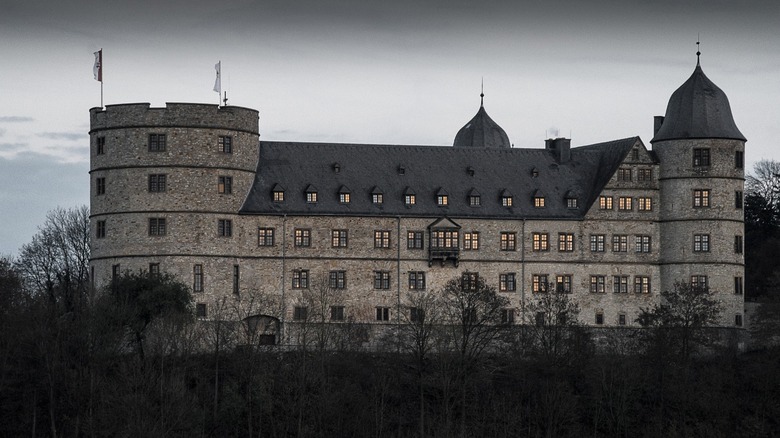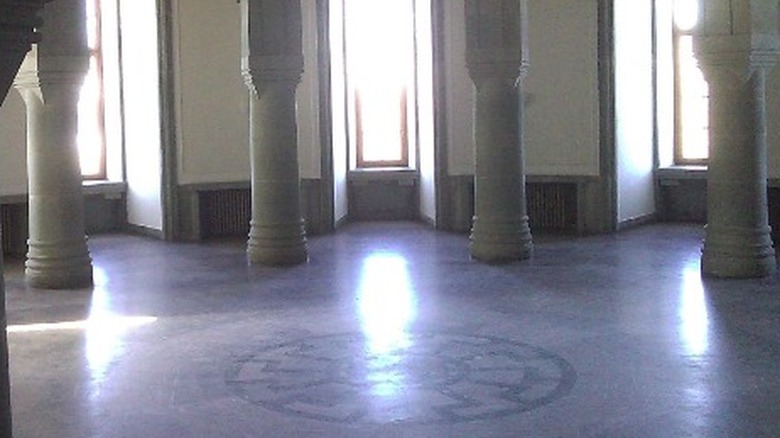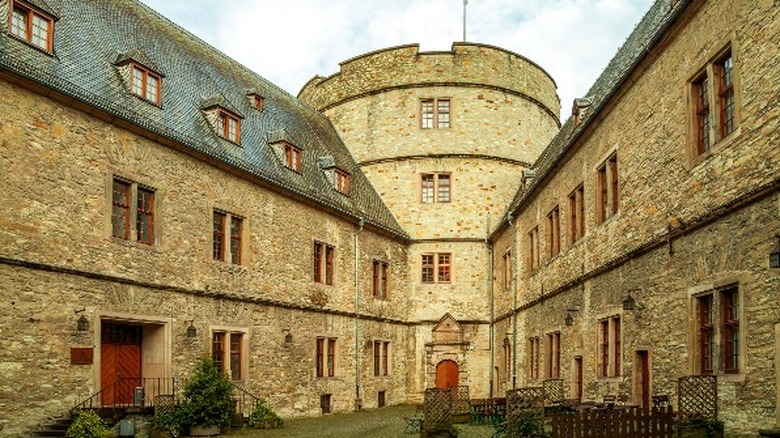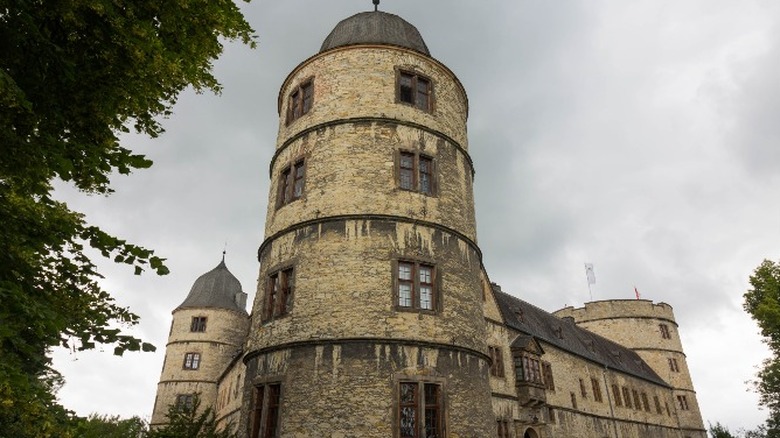The Youth Hostel That Was Once A Nazi Castle
If you stay at the Wewelsburg Youth Hostel, you'll get a little more than the traditional travel experience. You'll be, as their website boasts, "next door to history." The hostel is inside the 17th-century Wewelsburg Castle. Despite the castle's age, it's best known for its mid-20th-century use as a headquarters for the Schutzstaffel, or SS, the elite Nazi guards.
The castle was built in 1603 as a secondary residence for the Prince-Bishops of Paderborn. It is the only triangular castle in Germany (via Wewelsburg Youth Hostel). It fell into disuse by the 18th century and slowly declined into ruin. However, it was renovated by 1925 to house a restaurant and museum, among other things (via Heritage Daily). The Nazis began using the castle in 1934. They attempted to blow it up at the end of the war, but only succeeded in burning parts of it. It was restored by 1950, according to the KreisMuseum Wewelsburg.
The SS at Wewelsburg
According to Heritage Daily, SS leader Heinrich Himmler became interested in Wewelsburg Castle when he was looking for a place of retreat for SS members. He specifically wanted a castle and nearly chose Schwalenburg Castle instead. In 1934, he took out a 100-year lease on Wewelsburg (via The Local). Within a year, the castle was completely closed to the public, according to the KreisMuseum Wewelsburg.
Rather than just a retreat, it became the SS's leadership school, where recruits received ideological training. The teaching became focused on the racial ideas of the Nazis and their supposed basis in Germanic history and folklore. The SS also established an archaeological unit at the castle that was meant to find proof of these ideas (via Heritage Daily).
Important meetings of the SS took place here, including on the eve of the invasion of Russia in 1941. Later in the war, adjacent buildings were used for other purposes like training Hitler Youth (via KreisMuseum Wewelsburg).
Himmler's renovation of the castle
Beginning in 1939, Himmler oversaw a major renovation of the castle, during which he made some bizarre changes. He wanted to make it look more like his idea of a castle, so he had a bridge and tower rebuilt and plaster removed to expose the exterior stone (via The Local). Inmates from a nearby concentration camp were forced to work on the construction, according to the KreisMuseum Wewelsburg.
He added a round crypt in the bottom of the castle, based on Mycenaean domed tombs (via Heritage Daily). It had a swastika on the ceiling and 12 pedestals evenly spaced around the room, according to The Local. Additionally, there was a gas pipe in the floor that may have been intended to feed an eternal flame (via Heritage Daily). Though there are rumors Himmler conducted pagan rituals here, a historian from the KreisMuseum told The Local he doesn't believe it.
Above the crypt was "The Hall of Supreme SS Leaders" (pictured), also a round room with 12 stone pillars and a black sun symbol in the floor (via The Local). This room was used for meetings, which SS General Karl Wolff described as Himmler "playing like King Arthur with his knights of the round table" (via Heritage Daily). Many of the rooms in the castle were renamed with Arthurian allusions, such as The Grail.
The Nazis' obsession with the occult
Himmler's interest in these legends dovetailed with his interest in the supernatural and the occult, a preoccupation many of the Nazis shared, including Hitler. Himmler's interest had begun at an early age, according to Heritage Daily. He managed to combine these ideas with his racist ideology. He created what Heritage Daily calls "a cult of ancestor worship and racial doctrines" at Wewelsburg, based on Germanic myths and mysticism.
He had chosen Wewelsburg Castle partially because of the prophecies of his own personal occultist, Karl Maria Wiligut. Wiligut worshiped the Germanic god Irmin and believed magical creatures had once roamed the earth. He also suffered from schizophrenia (via Big Think).
The Nazi belief in myths and the occult predated Wiligut's involvement, however. The Nazi Party was originally founded by members of the Thule Society, which believed the Aryan race had superpowers they lost by interbreeding with apes. This interbreeding created all other races, according to their ideology. They also believed in the mythical island of Thule, otherwise known as Atlantis, which was occupied by Aryans. Beliefs like these, as well as pseudo-science like astrology and fortune-telling, informed the Nazis' inhumane policies toward minority groups (via Big Think and HistoryNet).
The youth hostel
The hostel makes no secret of its connection to that part of history; it has an adjacent museum with a permanent exhibit on the SS and advertises this on its website. The museum is housed in an old SS guard building in the castle's forecourt. The hostel is also open about being near the location of a former concentration camp.
However, they highlight happier things on their website as well, boasting about their music and sports rooms and the surrounding countryside. They describe the hostel as a "combination of rustic walls and modern facilities." For those interested, the hostel is near the town of Paderborn, with its historic cathedral and computer museum. There's a forest nearby for hiking, caves for exploring, and the Lippe River for canoeing. Room prices average around €40 ($42).
The hostel predates Nazi occupation of the castle, having originally been there from 1925-34. It was reestablished in 1950 (via KreisMuseum Wewelsburg).
The KreisMuseum Wewelsburg
The adjacent museum, the KreisMuseum Wewelsburg, is primarily dedicated to the history of the Prince-Bishopric of Paderborn. However, they also present special exhibitions on a wider range of local historic and cultural topics.
The permanent exhibit on the SS is about 850 square meters in size within the former guardhouse. It presents the entire history of the SS, as well as the things they did at the castle and elsewhere in the region. It delves into the ideology of the SS and the far-reaching repercussions of the crimes they committed in the name of that ideology. The exhibit also has a section on Nazi concentration camps in general and specific information about what happened at the camp that was near the castle. The entire display includes Himmler's diary, uniforms of the SS and the concentration camp prisoners, and barrack walls from the camp, among other things (via the KreisMuseum Wewelsburg and The Local).
The castle unfortunately attracts the attention of neo-Nazis, and an administrator told The Local they "reserve the right to throw people out" if someone behaves inappropriately. Otherwise, the castle is open for business.





